Do People Consistently Sing Along to the Melodies You Write For Your Songs?
If Not, There Are Methods You Can Use in Your Melody Writing to Get People to Want to Sing Along to Them
We'll Talk About Those Methods Here...
Melodies are incredibly important to a great song. They create that initial attraction to a song that makes people want to hear it again. You can have the most profound lyrics ever written, but it they’re attached to an uninteresting melody, no one’s going to stick around to find that out.
A great melody should easily stick in the heads of anyone who hears it. There’s nothing worse than spending a ton of time on one of your songs only to have a melody people can't sing along to because it’s not very singable!
So I have to ask… When it comes to your songs:
- Are people consistently singing along to your songs’ melodies?
- Do listeners easily remember your melodies when they’re done listening to your songs?
If not, you probably just need to know the specific elements that most great melodies have in common. After all, those elements are what’s making them appealing to listeners.
The great part is you can incorporate these elements into your music without compromising yourself as an artist. You might be afraid that if you learn or apply certain techniques to your melodies, your songs will be too cookie cutter, but you don’t have to worry about that. There are plenty of approaches you can use that will make your melodies better, without forcing them into a sound you’re not interested in.
You’ll keep all your creativity, without becoming a “cookie cutter” artist. By taking certain approaches to how you write your melodies, you can greatly increase the chance of getting your listeners to want to hear them again.
How Bad Song Reviews Were Helpful
For no apparent reason, I used to think I was the greatest songwriter around when I first started writing songs (I definitely wasn’t, as you’ll find out in a second). So one day I decided I’d stroke my ego and submit one of my songs for a professional review to see all the "great things" that would be said about it. Haaa... wow, was I wrong! My song got TORN APART in that review.
I wanted to find out if it was just a fluke, so I submitted a few more songs for review, with the same brutal results. Those reviews were stomping all over my hard work and creativity, so they were tough to swallow!
But looking back on it, those reviews were deservedly bad. My music wasn’t innovative, like I wanted it to be. Instead, my music needed a LOT of work to make an impact on listeners.
One of the things that appeared as a theme in those early reviews was that my melodies were all over the place. In other words, they were practically unsingable. I wanted my melodies to be original, so I had these long, drawn-out melodic segments which I thought made me innovative, when in fact they were just fairly tough to sing (for me AND my listeners).
I was also letting my lyrics dictate my melodies, so my melodies were losing a coherent musical form in order to make certain words fit into my song. That was also a bad idea.
Then I thought about all of my favorite songs by artists I love and how easy they were to sing. I realized one of the things that kept coming up in so many quality hit songs, is a memorable and singable melody. The hit songs I loved weren’t anything like my own crazy, random melodies. I needed to understand what the best songs were doing melodically, if I wanted to write great melodies myself.
Before that, I didn’t realize that if you want to innovate it’s best to know the methods that have worked again and again in other successful songs. THEN you can use them to make your song great, or you can creatively stray from those same ideas to make your melodies innovative. Either way, you win. But you have to know what those concepts are first.
With that realization, I decided to build a solid songwriting education for myself and make it my mission to know what makes melodies listeners want to hear. I read books, and went to seminars and workshops given by the best and most accomplished songwriting teachers around. I learned all the best tips, tricks and techniques there are. Some of what I learned worked and some didn’t. But the stuff that worked, worked incredibly well.
As I started to learn more and more about crafting great melodies, I developed the ability to see what made successful songs work so well, while other songs didn’t. It became almost instantaneous when I listened to a new song.
I ended up analyzing a ton of hit songs for articles on my own website and for other great songwriting websites, like USA Songwriting Competition’s Blog and CD Baby’s Do It Yourself Musician’s Blog. I’ve even had my writings appear as examples in the book Songwriting Without Boundaries, by Pat Pattison, who’s an acclaimed Lyric Writing Professor at Berklee College of Music.
Apply the Best Ideas to Your Melodies
Once I noticed I could see songs in this way, I realized I’d have to put these ideas into a course to be able to give other songwriters the ability to clearly see what can make their songs work, while sparing them information that doesn’t work. Not to mention saving them time too.
And that’s what I’ve done. There are very specific concepts you can apply to your melodies to make them singable, interesting AND innovative. I’ve compiled the best of these ideas into an online video course called How to Write Songs That Sell: The Melodies Module.
How to Write Songs That Sell: The Melodies Module is going to save you a LOT of trial and error when it comes to writing incredibly effective melodies your fans won't be able to stop singing.
This course will teach you two methods for writing melodies. The first method is called the Find Inspiration Method, where you’ll learn how to specifically draw inspiration and get ideas from other songs, and turn them into songs that are completely your own. You’ll be able to dismember a current melody, examine the parts, change them and then put them back together to create a whole new song of your own. You’ll never understand an existing melody (or your own) so well as when you take this approach.
The second method you’ll learn is the Do It Yourself Method, where you won’t be relying on other songs at all. It’ll show you how to create melodies people want to hear completely from your own brain.
If you decide to combine parts of these two methods together, you’ll see great results. Great artists are always looking to other artists for ideas, while at the same time innovating from their own minds. If you combine the two methods, you have a great opportunity to do that yourself.
So, What is The Melodies Module All About?
How to Write Songs That Sell: The Melodies Module is a comprehensive program that walks you through all the pieces you need for creating a melody people want to hear, so you could drastically improve your melodies in just days.
Every time I've taken an online course, I’ve found the best way to learn is to start by watching videos so I can have the concepts shown to me and easily explained.
Then if I need to revisit one of the ideas or concepts, I’ve always found it helpful to have a transcript, since it makes those concepts really easy to find when I need to reference a specific one.
I also like the idea of having the audio of what’s in the videos, since audio lets you absorb the contents of the course anytime and anywhere you want. Plus, the audio format makes it easy to listen to the contents of the course several times, getting it ingrained in your brain so you hardly even have to think about what to do.
For those reasons, I’ve created The Melodies Module as an online video course, but I’ve also included a downloadable pdf transcript and mp3 audio file of the videos as well.
If you learn the same way I do, you’ll find having the information in all three of these formats helpful. And if you don’t absorb information the way I do, you can choose whichever format works best for you and how you learn.
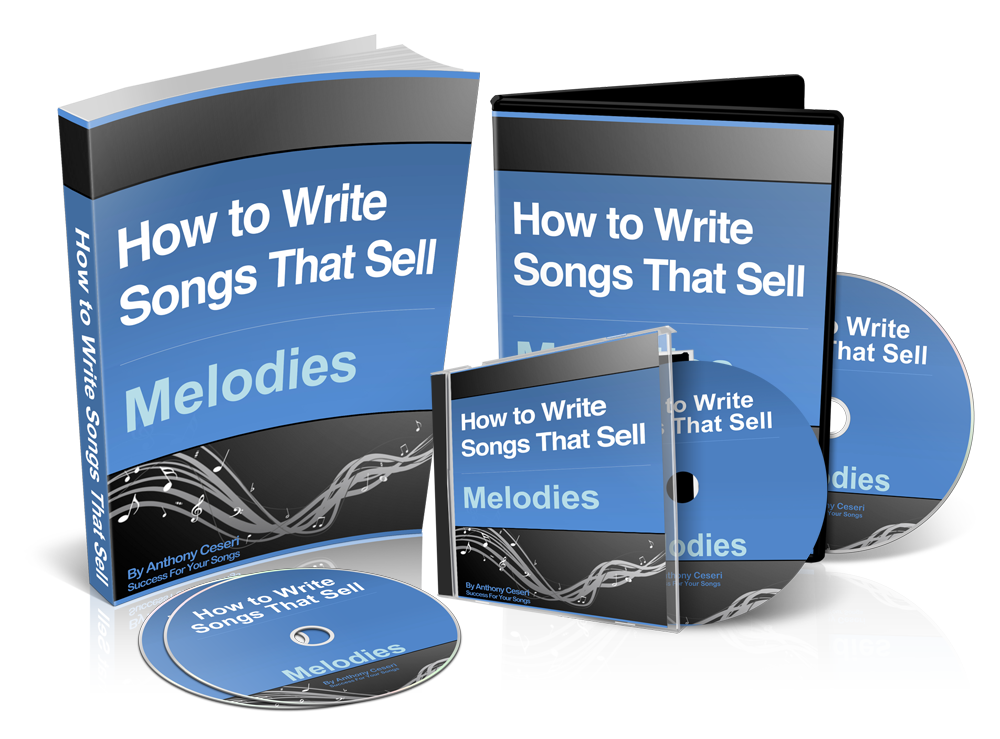
What You'll Learn
Since great artists frequently reference other artists they’re inspired by and they also innovate from their own minds, the Melodies Module is broken up into 2 different methods, as I mentioned earlier:
- The 1st method is called the Find Inspiration Method which shows you how to write original melodies by specifically referencing existing successful songs
- The 2nd method is called the Do It Yourself Method, which shows you how to generate melodies from your own head, in a way that will get rid of your writer's block forever.
To give you an idea of the depth of this program, let's take a look at what you'll find inside.
The Melodies Module will show you how to write creative but catchy melodies for your songs. You don't have to be a naturally gifted melody writer in order to come up with great, memorable melodies, so we'll cover:
- How to create a strong melodic hook in your music to keep your listeners addicted to what you're singing
- How to use the right combination of repetition and change to create catchy melodies
- The scales available to you for your melodies in each key of 6 different modes, and how to turn them into a melody over any chord progression (or before you even have a chord progression)
- How to organize your scale or chord notes into patterns to come up with a singable melody your fans will love
- How to avoid writing overcomplicated melodies that are hard to sing (for you AND your audience)
- How to reference proven successful melodies to give people a familiar sound, while at the same time making the melody completely your own
- How to change the rhythm of a melody to give it a completely different sound
- How to change the notes in a melody (while keeping its rhythm) to come up with a fresh idea
- How to create a powerful contrast in your melodies as your song travels from your verse to your chorus, in a way that will keep your listener excited each time they hear a new part of your song
- How to create melodies that match the intent of your song’s big idea
- What the 2 components of a melody are, and how changing anything aside from those two components won’t affect your melody at all
- How to strategically separate your melody from your lyrics to come up with a marketable sound
- A cool trick for making your listeners want to hear your melody again and again
- How to develop memorable melodies every time you sit down to write a song
- How to easily write melodies people will sing along to
- How to easily create memorable and creative melodies in your song, in order to keep your song in your listeners' heads, so they’ll want to hear it more often
- How to be consistently writing melodies as you go about your daily activities
After going through How to Write Songs That Sell: The Melodies Module, you'll always have a way for coming up with a melody and you’ll never be stuck with something that’s uninteresting to your listeners. And you don't even have to know how to read music to make it happen.
You Also Get...
The Chord and Melody Writing Cheat Sheet
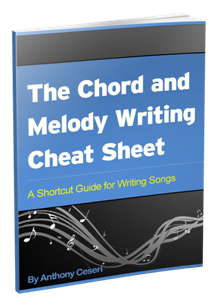
The Chord and Melody Writing Cheat Sheet is a collection of charts for you to use when you're writing. It includes all the scales in 3 major modes (Ionian, Lydian and Mixolydian) and 3 minor modes(Aeolian, Dorian, Phrygian) in every key AND the major and minor blues and pentatonic scales in each key, giving you a plethora of options for writing melodies in practically any style. It even gives you the guitar tablature for each of those scales to make it easier for you to figure out your melodies if you're a guitar player.
It also gives you 6 chord charts with all the chords available to you in the 3 major modes and 3 minor modes in every key, so you can experiment with a variety of different sounds when you're writing.
And it has a guitar capo chart so you can easily change the key of a song using a capo and still know what chords you're playing.
If it sounds like all these charts are overwhelming, don't worry -- I show you exactly how to use them in the Melodies Module. Once you start writing with these charts, you'll never know how you wrote without them.
There's More...
There's a lot more that you get with this program. To give you even more resources, I've gone ahead and put together some great bonus lessons for you.
Melody Writing Bonus Lessons

Examples of Rhythm in Phrasing
This lesson contains several audio examples showing you different ways to arrange the rhythm of your notes to give you plenty of melody writing options.

Using Melody Maps to Lay Out the Melodies for Your Entire Song
If you’ve ever been able to come up with a line or two of melody, but didn’t know how to spread those melodic lines out into an entire song, this lesson will help you do that.

How to Create Contrast in Your Melodies
Creating contrast between the sections of your song is an important way to keep your melodies interesting. This topic is covered in the Melodies Module, however this lesson will show you even more ways for creating contrast with your melodies.

The Rules of Two’s
This lesson outlines a quick and easy trick for creating memorable melodies, while looking at a few Beatles songs as examples.

A Simple, But Interesting Melody Idea
This lesson shows you a hit song that using a great trick for keeping a melody super simple to keep it singable, without having it come off as overly repetitive or boring.

Using Falsetto to Color Your Melodies
This lesson will show you an example of a hit song that uses vocal delivery to color a melody. It’ll show you a great technique you can use to decorate your melodies to give them your own style.

Using the Modes as a Basis for Your Melodies
There are several different scales you can use as a basis for your melodies. This lesson outlines those scales for you with audio clips, so you’ll know how each of them will fit into your music.

Examples of Organizing the Modes into Phrases
Since hearing examples can be such an effective way to learn, this lesson uses audio examples to show you how to take the notes in your key and organize them into patterns you can use to build your melodies.

5 Aspects of Vocal Delivery That Affect Your Melodies
While a particular melody may read only one way on sheet music, it can sound very different when sung by different singers. This lesson discusses how you can use your vocal delivery to sing any given melody in your own style.

There are Also 9 Bonus Melody Writing Audio Segments that Show You:
- How to write a melody over any chords you've written
- The importance of starting your melody on different beats
- A clever hit song melody writing example and why it works, so you can use it yourself
- The importance of being able to write a melody before you write your chords
- How to easily write a strong melody [VIDEO]
- How to design an effective melody throughout your song
- How to choose notes for your chorus so all of your sections don't sound the same
- Several easy melody writing tricks you can use right away
- A sneaky technique for making a melody sound fresh when you go from a verse to a chorus
The Sandbox Bonus
Since I want you to make the best use of what you're learning, I've also included a section called "The Sandbox."
The Sandbox contains a series of exercises that will give you the opportunity to implement the concepts you learned right away, so they'll stick in your head and not be something you learned and then forgot about.
It'll also make these concepts something you've had experience with, making it much more likely for you to use these ideas in your melodies in the future. This will help you be a more efficient songwriter as you move forward with your writing.
What People Are Saying About This Course
At this point, I'd like to let you quickly hear what some of the other people who have already gone through the course have said about it.
So, take a quick listen by clicking the play button below:
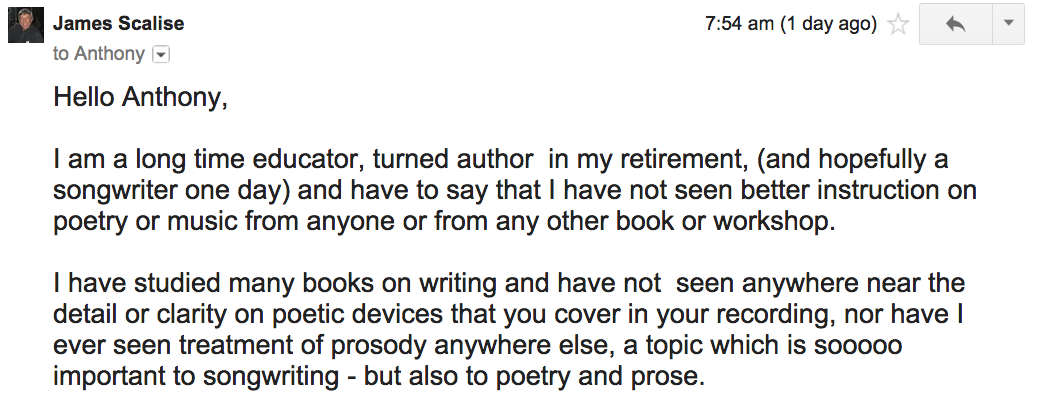
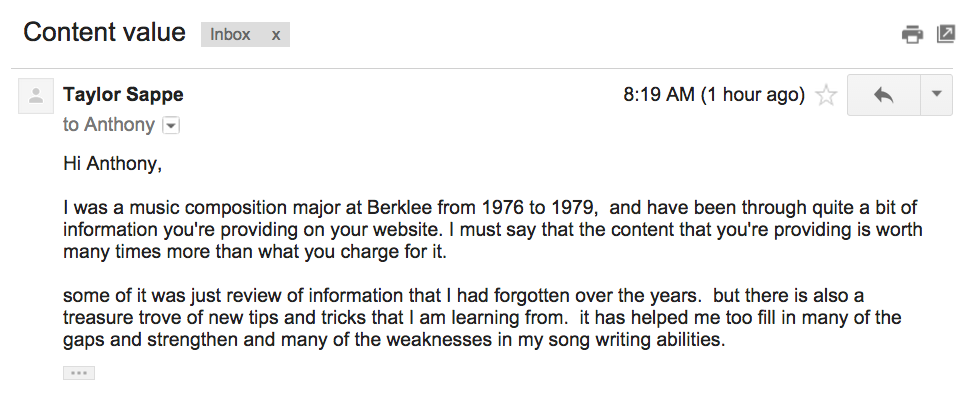
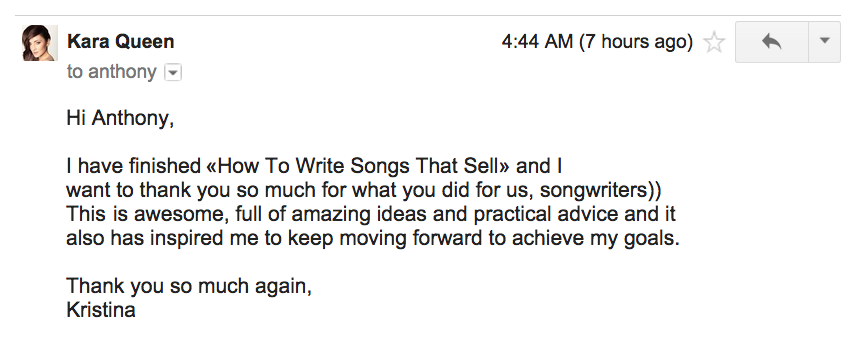


"You’ve managed to encapsulate a lot of great material in a well organized fashion. You obviously have a gift for teaching, in addition to your excellent grasp of the craft of songwriting."
- Dave Nachmanoff, Songwriter & Guitarist for Al Stewart
"This is a masterpiece. This is the piece of the puzzle I've been missing!"
- Charles Kelly, Texas
"There are very few songwriting books that I haven't read. I have my favorite authors/teachers, with Jason Blume, Robin Frederick, and Ralph Murphy topping the list, and I am most sincere when I tell you that your course is now up there on my 'go-to' and 'recommendation' lists. Great job, Anthony!"
- Avrim Topel, Delaware
A Recap of Everything You Get
Let's do a quick recap of everything you get, which I mentioned in more detail above:
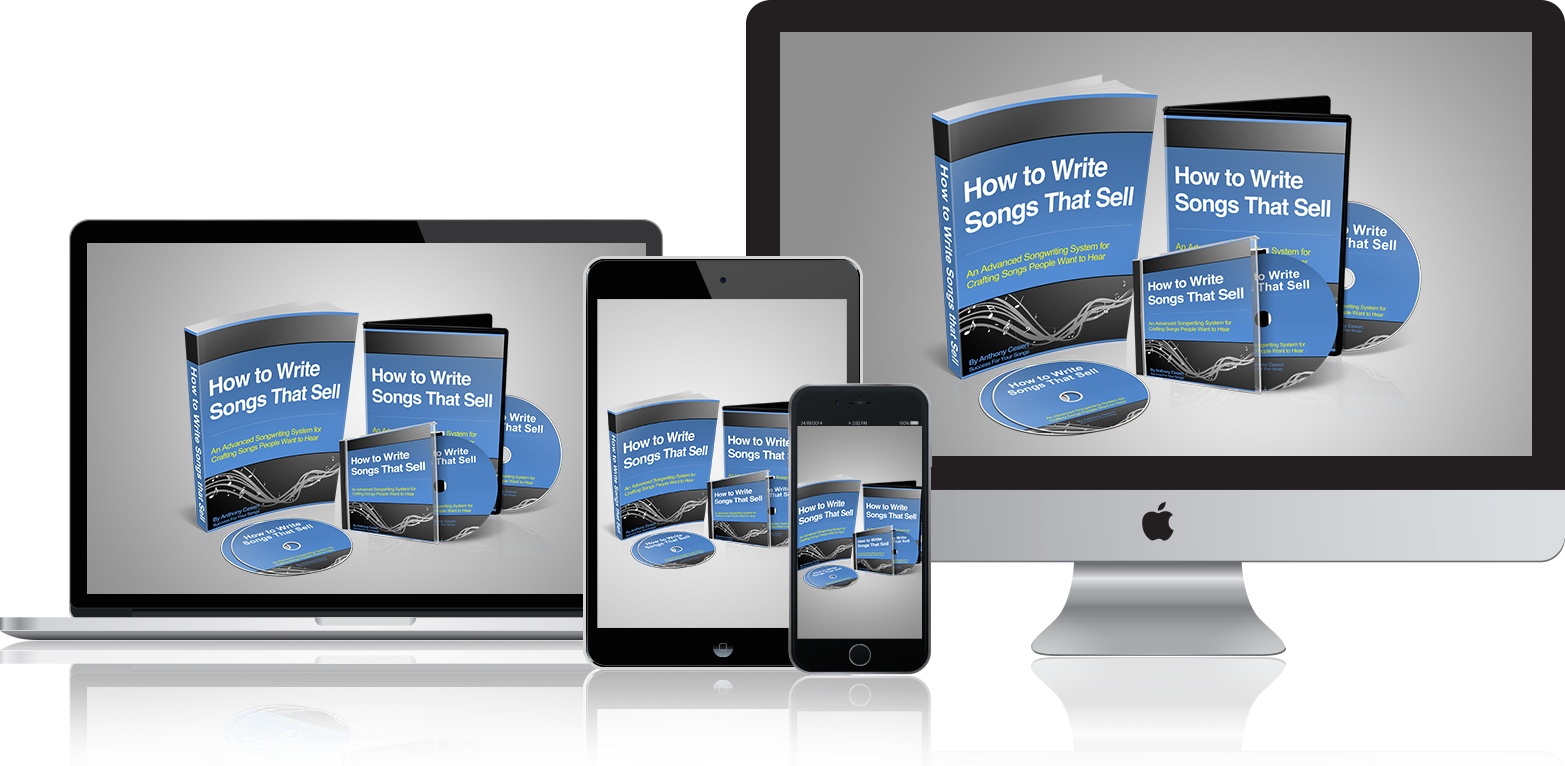
This is a pretty mind blowing amount of information you’re about to get access to.
So now the big question... How much is this whole program?
What's it Worth?
To wrap this up, you’re going to be getting the Melodies Module in multiple formats, the invaluable Chord and Melody Writing Cheat Sheet, AND the 18 bonus lessons and audio segments. For the whole package, you’d probably expect to pay in excess of $100. And it’d be totally worth every penny. The bonus items alone are worth at least $50. Once you get addicted to the charts provided in The Chord and Melody Writing Cheat Sheet alone, you’ll know exactly what I’m talking about.
But instead of $100 for the Melodies Module, today you're going to get access to everything for just $27. The price will not stay this low for very long, so if you’re even considering taking advantage of this deal, do it NOW by clicking the big orange button below. You’ll have immediate access to all of the material.
At this price, anyone who's not jumping at this probably isn't right for the course.
And what kind of offer would this be, if I didn't give you a complete money back guarantee?

60 Day 100% Money Back Guarantee
So you can see how serious I am about everything I’ve told you about this course, take 60 days to go through the material so you can put everything into action and see if it does everything I said it would for you.
If you’re not satisfied for any reason, no worries — just let me know within 60 days and you’ll get every penny of your money back. No questions asked.

Your low price for today:
$27
To get started with the online video course, How to Write Songs That Sell: The Melodies Module (which also comes with downloadable pdf transcripts and mp3 audio files of the videos), The Chord and Melody Writing Cheat Sheet in pdf format, AND all of your bonus melody lessons and audio segments, click that big orange button below. You’ll have instant access to all of your content:
As a last note, I want to take a second to THANK YOU for your interest in this course and for being a part of an awesome community of songwriters who are excited about creating melodies people want to sing along to.
I really look forward to working with you as part of the Melodies Module. I hope you take advantage of this course, so we can take your songwriting to another level and get you consistently writing amazing melodies your fans will love.
Remember, to get started using all of the content we talked about, click the big orange button above and I’ll see you on the inside. Thanks!
Anthony Ceseri
Frequently Asked Questions
If you’re still on the fence about getting this program, here are the answers to some of the most commonly asked questions about the course:
-
Q.Is this a recurring billing membership?
A.No, this is a one-time payment.
-
Q.How long will I have access to the material?
A.You’ll have access to How to Write Songs That Sell: The Melodies Module forever.
-
Q.When do I get access to the content?
A.Immediately. You can access all of the information in How to Write Songs That Sell: The Melodies Module right away. Your login and access information will be sent to the email address you provide, giving you access to your online material.
-
Q.Is your content iPhone/iPad friendly?
A.Yes. You will be able to access and view all of the content in this course from any of your mobile devices as long as you have an internet connection.
Once you’ve download the pdf transcripts and mp3 audio from the course, you will be able to access those items offline on any of your devices as well.
-
Q.What if I already have the older EBook version of How to Write Songs That Sell?
A.The older EBook version of How to Write Songs That Sell is no longer available for purchase. However, if you currently own it, this course contains a lot of the information that was included in that package. I’ve also added a LOT more new content to this online version of the course that was not contained in the EBook version.
If you own the older EBook version and you’re interested in this revised and updated online version, please email me by clicking the “Contact” link at the bottom, lefthand side of this page. For a limited time, I can offer you a coupon for a discount on this new version.
-
Q.What if I get it and I don't like it?
A.We have a very high rate of satisfaction for this course, so I’m pretty confident you’ll love it.
However, we do offer a 60 day no-questions-asked guarantee, so if you aren’t happy for any reason, just let us know within 60 days of your purchase and we’ll give you your money back. We obviously don’t think it’ll come to that, but if you’re even the least bit worried that this might not work for you, then put your mind at ease. You’ll either get the results you want or you’ll get your money back. It’s as simple as that.
If you have any additional questions about the course, feel free to contact me by clicking the “Contact” link at the bottom, lefthand side of this page. If not, click the big button below to get started right now:
Contact
If you have any additional questions about this course, please feel free to email me at: anthony@successforyoursongs.com
Terms of Use
In accordance with FTC guidelines, we want to make it clear that the customer testimonials we’ve received are based on the unique experiences and circumstances of the people who have submitted them. We cannot promise that you will experience similar benefits from using our product. We can not and do not make any guarantees about your ability to get results or earn any money with our ideas, information, tools, or strategies.
What we can guarantee is your satisfaction with our training. We give you a 60-day 100% satisfaction guarantee, so if you are not happy for any reason with the quality of our training, just ask for your money back.
All products and services by our company are for educational and informational purposes only. Nothing on this page, any of our websites, or any of our content or curriculum is a promise or guarantee of results or future earnings, and we do not offer any legal, or other professional advice. You alone are responsible and accountable for your decisions, actions and results in life, and by your registration here you agree not to attempt to hold us liable for your decisions, actions or results, at any time, under any circumstance.
Furthermore, by purchasing How to Write Songs That Sell and/or the Songwriting Success Circle, you agree to the following:
- You will use this product for your personal and private use only
- It may not be resold, repackaged or otherwise transferred
- Bonus materials may not be duplicated or distributed in any way without permission
- Success For Your Songs retains all rights to How to Write Songs That Sell, the Songwriting Success Circle and and any additional content they come with
- All free content provided by SuccessForYourSongs.com may not be freely distributed without permission from the site owner
Privacy Policy
We respect your privacy, and will never sell, rent, trade or give away any of your personal information from our site to any outside party. We hate spam just as much as you do.
The only email sent from our website is in response to an inquiry that you may send us, or as a result of joining our opt-in email list. Should you opt-in to our mailing list, an unsubscribe link will be provided at the bottom of every one of our emails.
If anything comes to your attention which could potentially be a violation of this policy, please let us know immediately so that we can investigate and try to correct it.
Member Login
If you're currently a member of any of our online courses, you can login to access your material here: http://successforyoursongs.com/report/login/

